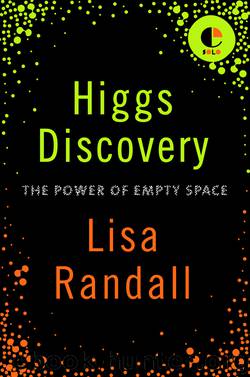Higgs Discovery: The Power of Empty Space by Lisa Randall

Author:Lisa Randall [Randall, Lisa]
Language: eng
Format: epub
Tags: General, Science
ISBN: 9781847922571
Publisher: Ecco
Published: 2012-07-24T00:00:00+00:00
The Problem
The weak force has one especially bizarre property. Unlike the electromagnetic force, which travels over large distances—which you benefit from each time you turn on the radio—the weak force affects only matter that is within extremely close range. Two particles must be within one ten thousand trillionth of a centimeter to influence each other via the weak force.
For the physicists who studied quantum field theory and quantum electrodynamics (QED, the quantum field theory of electromagnetism) in its earliest days, this restricted range was a mystery. QED made it look as if forces, such as the well-understood electromagnetic force, should be transmitted arbitrarily far away from a charged source. Why wasn’t the weak force also communicated to particles at any distance and not just to those nearby?
Quantum field theory, which combines the principles of quantum mechanics and special relativity, dictates that if low-energy particles communicate forces only a short distance, they must have mass; and the heavier the particle, the shorter the particle’s range. As explained in Chapter 6, this is a consequence of the uncertainty principle and special relativity. The uncertainty principle tells us that you need high-momentum particles to probe or influence physical processes at short distances, and special relativity relates that momentum to a mass. Although this is a qualitative statement, quantum field theory makes this relationship precise. It tells how far a massive particle will travel: the smaller the mass, the bigger the distance.
Therefore, according to quantum field theory, the short range of the weak force could mean only one thing: the weak gauge bosons communicating the force had to have nonzero mass. However, the theory of forces I described in the previous chapter works only for gauge bosons such as the photon, which communicates a force over large distances and has zero mass. According to the original theory of forces, the existence of nonzero masses was strange and problematic—the theory’s high-energy predictions when gauge bosons have mass make no sense. For example, the theory would predict that very energetic, massive gauge bosons would interact much too strongly—so strongly in fact that particles would appear to be interacting more than 100% of the time. This naive theory is clearly wrong.
Furthermore, the masses for weak gauge bosons, quarks, and leptons (all of which we know to have nonzero mass) do not preserve the internal symmetry which, as we saw in the previous chapter, is a key ingredient in the theory of forces. Physicists who hoped to construct a theory with massive particles clearly needed a new idea.
Physicists have shown that the only way to make a theory that avoids nonsensical predictions about energetic, massive gauge bosons is to have the weak force symmetry break spontaneously through the process known as the Higgs mechanism. Here’s why.
You might recall from the previous chapter that one of the reasons we wanted to include an internal symmetry that eliminates one of the three possible polarizations of a gauge boson was that a theory without the symmetry makes the same sort of nonsensical predictions I’ve just mentioned.
Download
This site does not store any files on its server. We only index and link to content provided by other sites. Please contact the content providers to delete copyright contents if any and email us, we'll remove relevant links or contents immediately.
The Complete Stick Figure Physics Tutorials by Allen Sarah(7134)
Secrets of Antigravity Propulsion: Tesla, UFOs, and Classified Aerospace Technology by Ph.D. Paul A. Laviolette(4973)
Thing Explainer by Randall Munroe(3782)
The River of Consciousness by Oliver Sacks(3409)
The Order of Time by Carlo Rovelli(3071)
How To by Randall Munroe(2911)
I Live in the Future & Here's How It Works by Nick Bilton(2839)
A Brief History of Time by Stephen Hawking(2818)
What If?: Serious Scientific Answers to Absurd Hypothetical Questions by Randall Munroe(2542)
The Great Unknown by Marcus du Sautoy(2532)
Midnight in Chernobyl by Adam Higginbotham(2384)
Blockchain: Ultimate Step By Step Guide To Understanding Blockchain Technology, Bitcoin Creation, and the future of Money (Novice to Expert) by Keizer Söze(2377)
Networks: An Introduction by Newman Mark(2264)
The Meaning of it All by Richard Feynman(2213)
Easy Electronics by Charles Platt(2204)
The Tao of Physics by Fritjof Capra(2162)
Midnight in Chernobyl: The Untold Story of the World's Greatest Nuclear Disaster by Adam Higginbotham(2074)
When by Daniel H Pink(2019)
Introducing Relativity by Bruce Bassett(2015)
